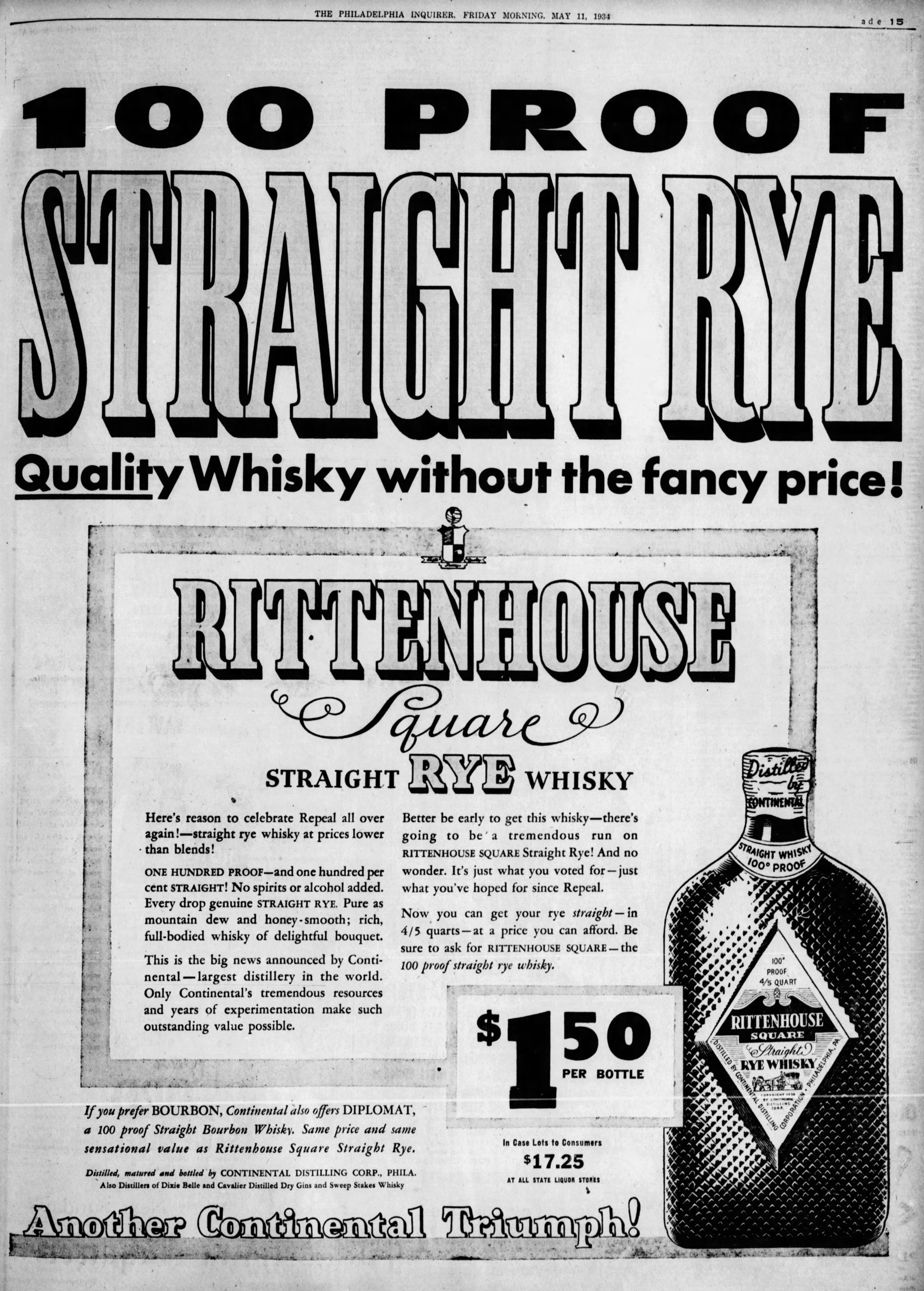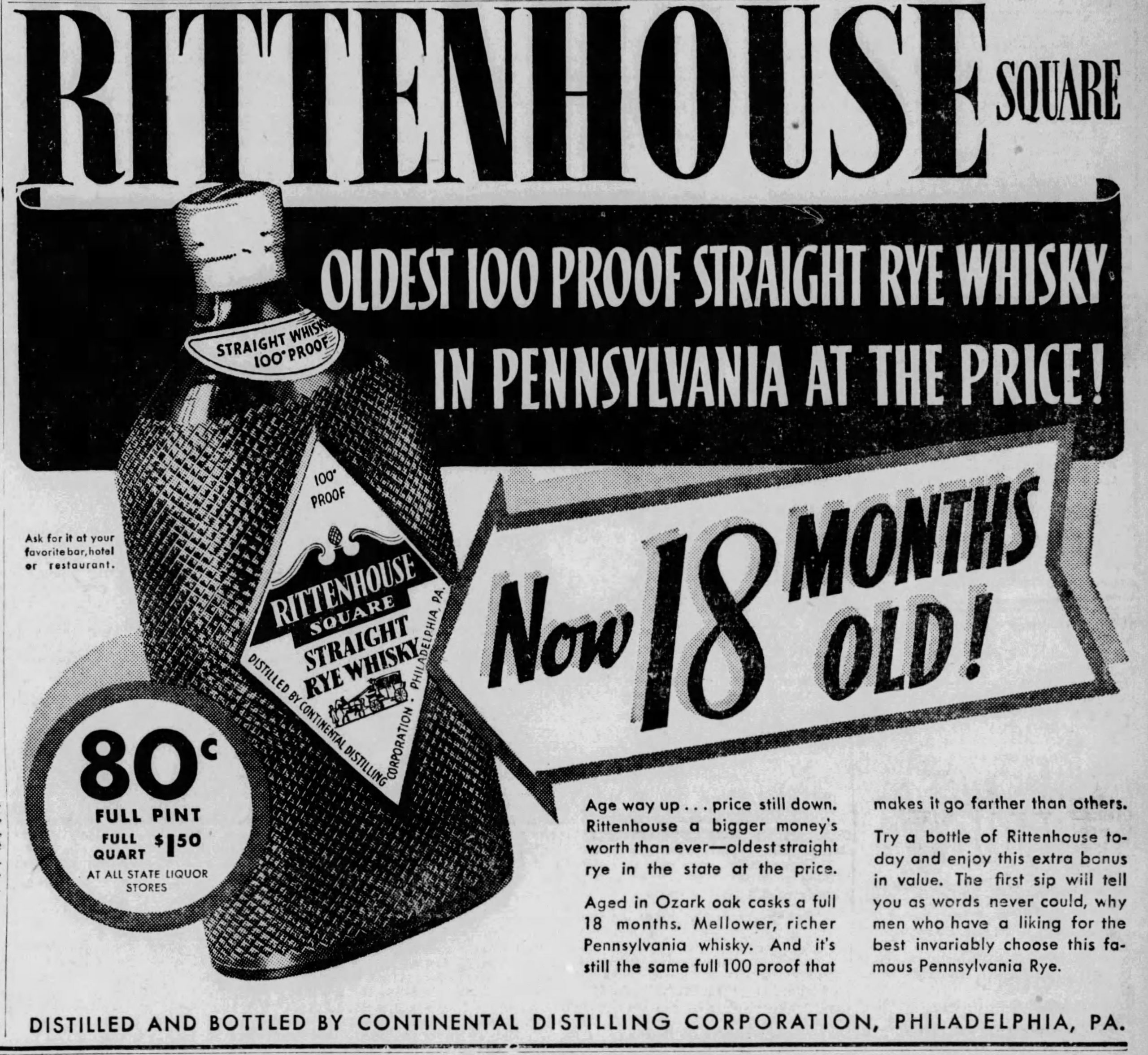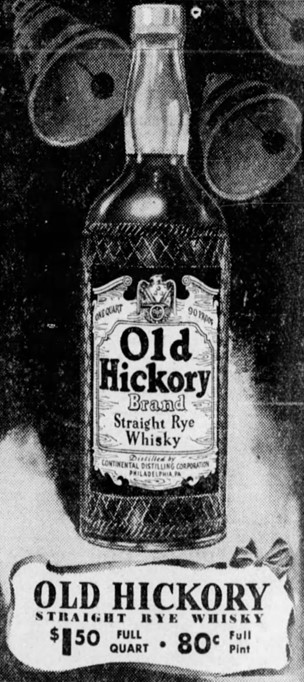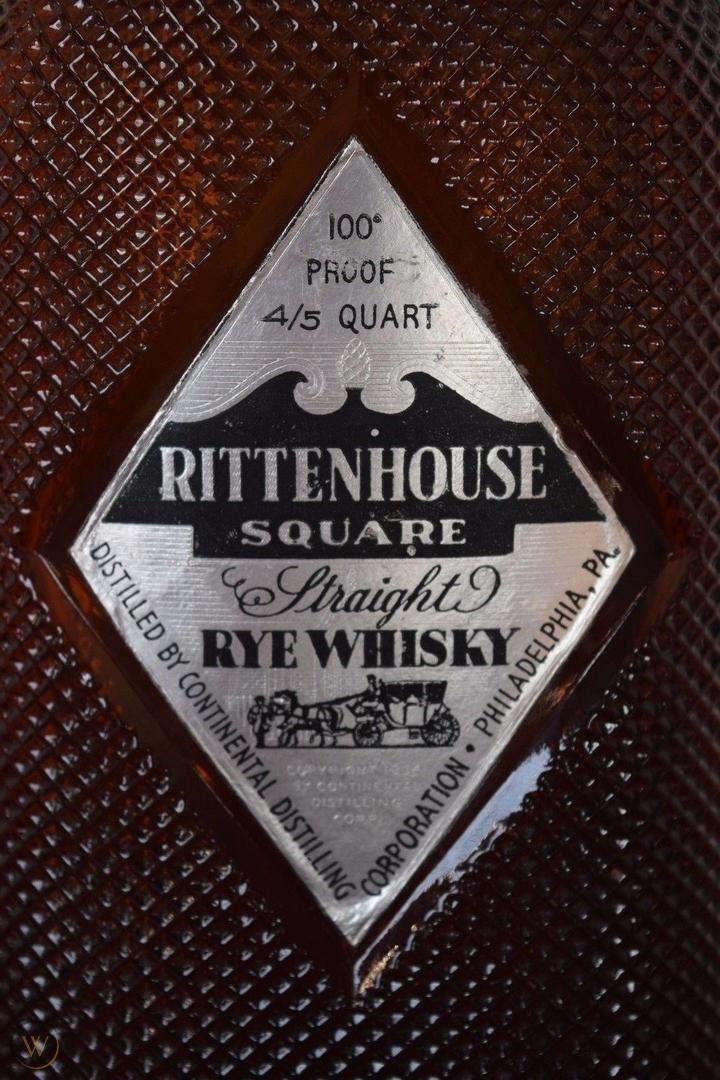Good ol’ Rittenhouse Rye Whisky. It’s been a standard sipper for the American rye drinker since it was launched by Continental Distilling Corporation as “Rittenhouse Square Straight Rye Whisky” in May of 1934.

Continental Distilling Corp. was a subsidiary of Publicker Commercial Alcohol Company. Both companies were founded by the incomparable Harry Publicker. Publicker emigrated from the Ukraine when he was only 6 years old, and came to know Philadelphia’s cooperage/distilling industry through his father, Jacob, during the late 1890s. Jacob, Harry, and his brother Philip, built their businesses up from nothing and did so in one of the poorest neighborhoods of Philadelphia- known locally as “the Neck.” Harry had done so well, in fact, that he was laying the foundations for his Publicker-Ward Distillery in South Philadelphia by 1913. He seemed to have no real concern for Prohibition as it approached and was still expanding his facility and building new warehouses in 1917. While America’s distilling companies were dissolving their assets, Publicker was doing the impossible. Harry Publicker effectively created an alcohol manufacturing powerhouse DURING Prohibition! The Philadelphia facility grew from a 6 million to a 60-million-gallon capacity industrial alcohol plant during the 1920s.
As Prohibition was drawing to its inevitable conclusion in 1933, Harry Publicker was poised to open the largest distillery in the world. Continental Distilling was built upon the site of the old Publicker-Ward distillery at Snyder and Swanson Streets at a cost of $27 million dollars. Publicker was not only up to the task of starting back up in the whiskey business, he was able to compete with the Big Four producers (Schenley, National Distillers, Seagrams and Hiram Walker), ranking as America’s 5th largest whiskey producer after Repeal.

Continental was issued the first state-issued license to operate a distillery since Prohibition and wasted no time firing up its stills! (This “first” does not include the US government-issued licenses to distill after 1929 that were given to Joseph A. Finch/Schenley, Large, or Overholt’s Broad Ford Distilleries to produce medicinal rye whiskeys DURING Prohibition.) The company’s PA distilling license was issued in September 1933, 3 months before Repeal. But if Rittenhouse Square Rye Whisky was released as a straight rye whiskey in May 1934…how can that be? How could a distillery that’s only been producing for less than a year be releasing a straight rye whiskey? Well, folks, while it’s not often made clear, there was NO SUCH THING as a legal definition for straight whiskey until 1935! And even then, the law read like this:
(b) Straight whiskey is an alcoholic distillate from a fermented mash of grain distilled from a fermented mash of grain distilled at not exceeding 160 proof and withdrawn from the cistern room at not more than 110 and not less than 80 proof, whether or not such proof is further reduced prior to bottling to not less than 80 proof, and is-
(1) Aged for not less than 12 calendar months if bottled on or after July 1, 1936, and before July 1, 1937; or
(2) Aged for not less than 18 calendar months if bottled on or after July 1, 1937, and before July 1, 1938; or
(3) Aged for not less than 24 calendar months if bottled on or after July 1, 1938.The term “straight whiskey” also includes mixtures of straight whiskey, which, by reason of being homogeneous, are not subject to the rectification tax under the Internal Revenue Laws
Rittenhouse DID NOT claim to be 2 years old. It certainly did not claim to be bottled-in-bond until several years later. It just claimed to be inexpensive and widely available! The term “straight” was just an industry term that meant it was “straight from the barrel”…and that was pretty much it. Continental also claimed to be the largest distillery in the world in 1934, and they very likely were.

As the state stores began expanding their inventory in 1937, Continental launched the most extensive newspaper advertising campaign ever seen in Pennsylvania featuring their best-selling blended whiskey, Cobbs Creek, which was meant to compete with Canadian imports. Dixie Belle Gin and Rittenhouse Square Straight Rye were still heavily advertised, but a new product was being pushed as well- Old Hickory Straight Bourbon Whiskey. Old Hickory was originally released as a rye, but it became a bourbon to round out Continental’s portfolio. These products were now touted as being “EXTRA AGED” with “2 FULL years IN THE WOOD.” Rittenhouse was finally meeting our modern criteria for straight rye whiskey. By 1939, Rittenhouse was finally a bottled-in-bond product. The “Square” was dropped from the name soon after.

 Continental bought the Kinsey Distilling Company in the early 1940s and moved their distilling operations there in 1966. Rittenhouse had a new home. Some of the most collectible and expensive offerings bottled under the Rittenhouse rye label came from this time period. The whiskey distilling portion of Publicker’s business interests had slowly become deprioritized after Harry Publicker’s death in 1951. Si Neuman’s ambition and focus drifted elsewhere even as the whiskey was likely the best it had ever been. When Si Neuman died in 1976, his widow, Helen Neuman, became chairman of the board. She appointed R.S. Leventhal to serve as president and watched as her family squabbled for the next few years while the company collapsed. Leventhal sold Publicker’s many liquor brands for $35 million in 1979 and closed the Kinsey/Continental plant in Linfield, PA.
Continental bought the Kinsey Distilling Company in the early 1940s and moved their distilling operations there in 1966. Rittenhouse had a new home. Some of the most collectible and expensive offerings bottled under the Rittenhouse rye label came from this time period. The whiskey distilling portion of Publicker’s business interests had slowly become deprioritized after Harry Publicker’s death in 1951. Si Neuman’s ambition and focus drifted elsewhere even as the whiskey was likely the best it had ever been. When Si Neuman died in 1976, his widow, Helen Neuman, became chairman of the board. She appointed R.S. Leventhal to serve as president and watched as her family squabbled for the next few years while the company collapsed. Leventhal sold Publicker’s many liquor brands for $35 million in 1979 and closed the Kinsey/Continental plant in Linfield, PA.
Production of Old Hickory bourbon and Rittenhouse rye continued at the Packer Ave plant in Philadelphia until it was idled in 1982. The whiskeys had lost a lot of their value and their proofs were dropped to 86. The Kinsey warehouses in Linfield continued to hold aging stocks until 1986 when it, too, was closed for good. It was at this point that the Rittenhouse brand left Philadelphia and was moved to Kentucky.
The buyers, it appears, were the Medley Distilling Company in Owensboro, KY. There is no end to the confusion during these years…Medley was bought by Louisville-based Glenmore Distilling Company in 1988. Rittenhouse continued to be made by Medley during this time. In 1991, Glenmore merged with United Distillers to create the second largest liquor company in the United States. The following year, the company merged with Schenley Industries to create United Distillers Glenmore. Rittenhouse Rye must not have been high on United Distillers Glenmore’s list of priorities, because Heaven Hill acquired the brand just two years later in 1993.
Heaven Hill Distillery relaunched the 65 year-old brand with great success. The following is quoted from Larry Kass, who worked intimately with the brand during its launch: “I was first brand manager and then PR person for Rittenhouse (and Pikesville) at HH…Once upon a time a long time ago we paid Dave Wondrich a case of 10 yo Rittenhouse (kind of a mistake bottling but that’s another story) to do research into the brand history, and much of that is reflected here…HH acquired the brand…in 1993 along with a slew of other brands from Glenmore, where it went after Publicker. And BTW those older bottlings were 21, 23 and 25 yo, about 30 barrels of each*, I spearheaded that and there is a very interesting story behind those too…” Mr. Kass knows better than anyone how Rittenhouse came back from near obscurity in the early 2000s. Bartenders across the country began reaching for Rittenhouse Rye when mixing the classic Prohibition-style cocktails that were becoming so popular. The only time production of Rittenhouse Rye left Heaven Hill after their relaunch was in 1996 when their famous distillery fire forced production to relocate to Brown Forman for a short period of time.
Heaven Hill makes a good Kentucky style rye, but make no mistake- any association that Rittenhouse Rye might still have with Pennsylvania or its distilling traditions is a marketing gimmick. Their website description of the brand’s history is mostly fluff. Traditional Pennsylvania rye whiskeys were far more unique than they are ever given credit for and Heaven Hill’s write up is proof of that. Pennsylvania rye whiskey was not a monolith. There was no PA vs. Maryland rye. It is very likely that Rittenhouse rye was always made with corn and that does NOT make it any less a “Pennsylvania style” rye whiskey. Oddly enough, I have never seen references to the mashbill/recipe for Philadelphia’s version of Rittenhouse. It seems to me that if it mimicked a pre-Pro, pure rye whiskey recipe that Continental’s epic advertising campaigns would have mentioned it! They did not ever describe its recipe, however, which leads me to believe that there was very likely corn in there. Continental was a very large company and would’ve loved the opportunity to shave some expense off their huge grain purchases. Harry Publicker may have even sought to use as much corn as possible to lower his costs. It was not unusual for Philadelphia’s rectifying plants to use rye and corn in their products before Prohibition. In fact, there is plenty of historical evidence for it going back to the late 1700s and early 1800s! Perhaps Continental’s rye whiskey recipe will come to light, perhaps not. Either way, Heaven Hill’s use of corn in the mashbill would not have been abnormal for a Pennsylvania rye whiskey. What makes it abnormal is that it’s being made in Kentucky and NOT Pennsylvania! Personally, I love Rittenhouse rye, and it is always a staple in my home. I can’t say I’m thrilled that it’s being made in Kentucky or that Heaven Hill’s website spins a poor historic narrative, but at least they give credit where credit is due- Pennsylvania! I’ll drink to that!:)


